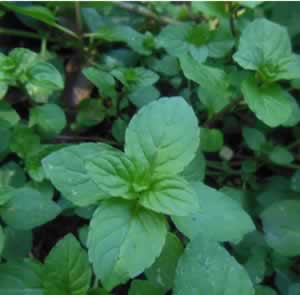Peppermint Mentha piperita

Chocolate peppermint
- Common Names
- Peppermint , Yerba Buena
- Botanical Name
- Mentha piperita
- Family
- LAMIACEAE
Medicinal Uses & Benefits of Peppermint
![]() How to Use|
Side Effects |
Plant & Garden|
Aromatherapy Oil |
Folklore
How to Use|
Side Effects |
Plant & Garden|
Aromatherapy Oil |
Folklore
- Medicinal Uses: * Aromatherapy
* Bronchitis
* Cardiovascular
* Christmas
* Colds
* Congestion
* Culinary/Kitchen
* Fatigue
* Flu
* Gastritis/ulcer
* Halitosis
* Headache/Migraine
* Herbal Teas
* IBS
* Insect Repellent
* Lice
* Nausea
* Nerve/Back Pain
* Pain Relief
* Sinus
- Properties: * Adaptogens * Analgesic * Anodyne * Antifungal * Antioxidant * Antispasmodic * Aromatic * Astringent * Breath * Carminative * Cholagogue * Cordial * Diaphoretic * Emmenagogue * Expectorant * Febrifuge * Hepatic * Insect repellents * Mental Clarity * Mood * Nervine * Refrigerant * Skin tonic * Stimulant * Vasoconstrictor * Vermifuge
- Parts Used: whole herb
- Constituents: volatile oils (composed mainly of menthol, menthone, and menthylacetate), flavonoids, tocopherols, carotenoids, betaine, choline, azulenes, rosmarinic acid
How to Use: Peppermint
We have had a long love affair with mints, as Pliny(23 AD � 79 AD) said:
“As for the garden Mint, the very smell of it alone recovers and refreshes the spirits”
Peppermint's uplifting aroma wafting up from a hot cup of tea can start to settle an upset stomach even before you drink it. Peppermint's antispasmodic effect calms nausea and helps prevent gas and bloating after a heavy meal. Peppermint is often combined with caraway to help indigestion. Those with IBS, irritable bowel syndrome, can find relief with enteric coated capsules of peppermint. 1
Peppermint is a first herb of choice for treatment of colds and flu because it acts to relieve multiple symptoms at once: congestion,headaches and muscle aches, nausea and fever. You can drink a hot cup of peppermint tea, diffuse the essential oil in the sick room to ease the breath and kill germs, and use the oil in chest and throat massages. Peppermint also makes a good additive for a foot bath.
You most likely have some "minty" products in your home now, with the taste and aroma of mint found in toothpaste, soaps, candies, and more. The menthol used as a key ingredient in creams, cough medicines, decongestants, and cigarettes sold at the drugstore is almost certainly manufactured in a lab and not from natural sources. These artificial mint flavors are to mint what 'truthiness' is to truth, in order to reap the many health benefits of mint you need the real thing. Luckily peppermint and spearmint are especially widespread and easy to acquire, both as plants for the garden, and dried mint leaf teas and essential oil from any natural product supplier.
Preparation Methods & Dosage :Peppermint is used as an essential oil, taken in capsules, extracts, and most often herbal tea.
- For cramps try boiling peppermint leaves in hot milk.
- Soak cotton balls or rags with peppermint (or clove) oil and place them where ants may be entering or hiding out.
- Take a quick whiff of peppermint oil for nausea.
- Diffuse peppermint oil in aroma lamps to clear the air in stuffy rooms.
- A few drops of peppermint essential oil in a cold compress cools the body and relieves a tension headache.
Peppermint Remedies
Peppermint : Essential Oil Profile
Peppermint has a powerful, sweet, menthol aroma which, when inhaled undiluted, can make the eyes water and the sinuses tingle. Cooling and refreshing peppermint energizes the mind and mood, helping to improve mental clarity and memory.
- Essential Oils for Congestion
- Arthritis Boggy Joint Oil Blend
- Abdominal Pain, Indigestion
- Refreshing Lime Peppermint
- Citrus Mint Refresher
- Cleansing Grains
- Peppermint pest control
- Icy Hot rub
- Peppermint Lemon Toner
- Peppermint Lemon Tripple Whammy
- Migraine compress
Peppermint Side Effects: Peppermint oil can cause skin irritation if not diluted properly. Avoid using the essential oil with babies.
Plant Description

Koehler's Medicinal-Plants 1887
- Plant Class: Perennial Herb: Peppermint is a hybrid of M. aquatica x M. spicata so seeds do not breed true.
- Flowers:Terminal spikes of lilac pink flowers.
- Parts used: Leaves and essential oil
- Leaves:Smooth, toothed, green,leaves
- Flowering Season:
- Distribution:Mint appears in every list of herbs passed down to us, Egyptian, Greek, Roman, medieval and American Colonial. There are some two dozen species, with hundreds of variations in the genus Mentha. All mints are native to Europe but are now grown the world over. In America by the turn of the century, 90 percent of the world's supply of mint oil came from an area within a ninety-mile radius of Kalamazoo, MI. Today most of the nation's peppermint is grown in the Pacific Northwest.
How to Grow Peppermint
Mints are hardy perennial plants, and they are very easy to grow. They require little or no maintenance, however, take over the garden if allowed. Mints are great in herb gardens, in beds along the house, or in containers. Harvest in the morning when the oils are strongest. Some of the most popular mints for the home garden are:
- Mentha spicata Spearmint
- Mentha pulegium Penny Royal
- Mentha suaveolens Apple Mint
- Mentha suaveolens 'Vargegata' Pineapple Mint
- Mentha aquatica Water Mint
- Mentha longfolia Horse Mint
- Mentha arvensis Corn Mint
History and Traditions & Folklore
Pliny tells us that the Greeks and Romans crowned themselves with Peppermint at their feasts and adorned their tables with its sprays, and that their cooks flavored both their sauces and their wines with its essence. Two species of mint were used by the ancient Greek physicians, but some writers doubt whether either was the modern Peppermint, though there is evidence that M. piperita was cultivated by the Egyptians. It is mentioned in the Icelandic Pharmacopoeias of the thirteenth century, but only came into general use in the medicine of Western Europe about the middle of the eighteenth century, and then was first used in England.
It was only recognized here as a distinct species late in the seventeenth century, when the great botanist, Ray, published it in the second edition of his Synopsis stirpium britannicorum, 1696. Its medicinal properties were speedily recognized, and it was admitted into the London Pharmacopoeia in 1721, under M. piperitis sapore. Among essential oils, Peppermint ranks first in importance. It is a colourless, yellowish or greenish liquid, with a peculiar, highly penetrating odour and a burning, camphorescent taste. It thickens and becomes reddish with age, but improves in mellowness, even if kept as long as ten or fourteen years. (Grieve, M.,537)
Peppermint's generic name, Mentha, is derived from the mythological origin ascribed to it, and was originally applied to the mint by Theophrastus. Menthe was a nymph, who because of the love Pluto bore her, was metamorphosed by Proserpine, from motives of jealousy, into the plant we now call mint. Mint was used by the ancient Assyrians in rituals to their fire god.
 It is an herb of Venus. This herb has a strong, agreeable, aromatic smell, and a moderate warm bitterish taste, it is useful for complaints of the stomach, such as wind, vomiting, for which there are few remedies of greater efficacy.
It is an herb of Venus. This herb has a strong, agreeable, aromatic smell, and a moderate warm bitterish taste, it is useful for complaints of the stomach, such as wind, vomiting, for which there are few remedies of greater efficacy.
Nicholas Culpeper, 1653
- Grigoleit HG, Grigoleit P. . Peppermint oil in irritable bowel syndrome , PubMed, ( 2005 Aug;12(8):601): Peppermint Oil (1-2 capsules t.i.d. over 24 weeks) may be the drug of first choice in IBS patients with non-serious constipation or diarrhea to alleviate general symptoms and to improve quality of life,












